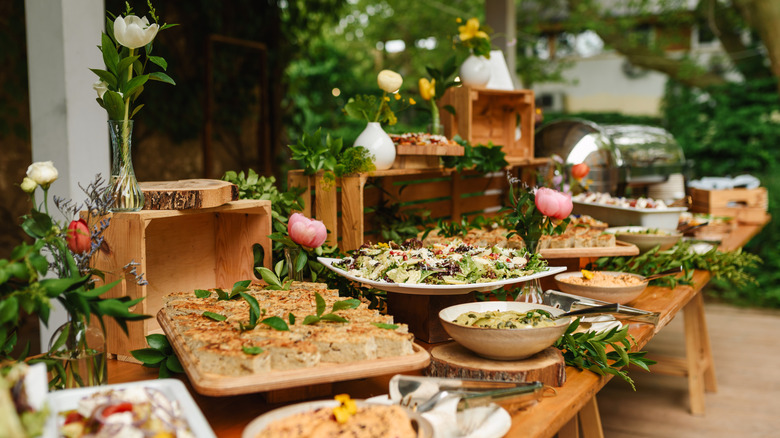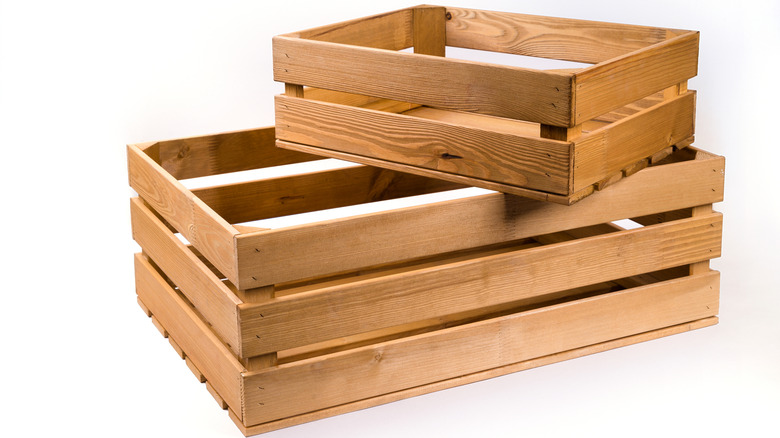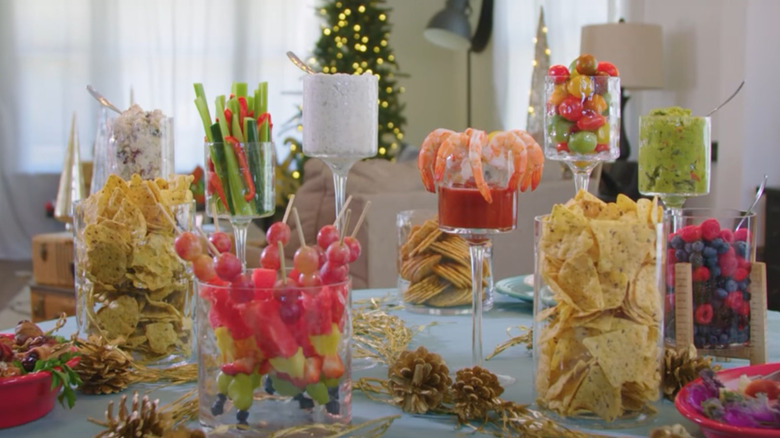This Genius Tip Helps You Fit More Food In Your Buffet Space
We may receive a commission on purchases made from links.
In places like New York City where space is scarce, city planners had no choice — build up instead of out. Take this lesson when it comes time to set up your buffet at your next dinner party. Don't try to make your buffet table longer. Instead, give your table a couple of tiers. It'll be like a cityscape constructed from serving plates, cake platters, and sandwich trays.
Ideally, your table-scape adheres to the rule of threes in decorating. The first tier is the table itself. The second tier stands six or eight inches off the table. The third tier comes in at 10 inches or higher. These numbers are a rough guide, of course. You just want the tiers to have significant enough height contrasts to make you notice the difference.
As a corollary to this principle, be strategic about the placement of your tiers. The tallest tier should be in the center of the table (or close to the wall, depending on how you've positioned your table) and the shorter ones should stand in front of that. It's a stair-step design that permits your guests to not only see everything that's on the table but to reach everything without the fear of knocking something over. Spills happen when the tallest items are positioned close to the table's outer edges, so avoid spills by being strategic about item placement.
Finding items to create the tiers
If you're starting to worry because you're envisioning how much this will cost, have no fear. It's possible to create different heights on your buffet with items you probably already have in the house. Some items, like a three-tiered sandwich tray, are made specifically for this purpose. Others, such as the step stool in your utility closet, wooden fruit boxes from the store, or your leftover Mason jars, can be transformed into something useful.
Here's how these might work. Place the step stool at the end of the table where the dishes and utensils go. Slide your stacks of plates underneath the stool and arrange the napkins and the silverware on the top. Clean Mason jars filled with cloth napkins function as silverware holders. If you don't own a step stool, use a serving tray on legs in its place. This set-up can also become the basis for a display at the center of the table. Just add charcuterie platters, side dishes, or desserts.
To create visual interest, put flowers, fruit, or other decorative materials underneath. Flank the sides of the display with pedestaled cake or cheese plates. Aside from making a home for your Italian cakes and pastries, those items create a resting place for sliced bread, condiments, or side dishes, too.
Filling in the gaps between items
Once you arrange the big items, you'll likely be left with small pockets between the tiers. That's when you'll appreciate items like a big martini glass or wine goblet, globed candle lamps with legged stands, and even stacks of your favorite books.
The martini glasses or heavy wine goblets become the resting place for small food items, such as nuts, specialty mints, and chip dip. You can strategically place them in the small nooks between serving platters. Fill the lanterns with items like grapes, tortilla chips, or savory crackers. If you allow the grape vines or the tails of your shrimp to spill out over the top of the lanterns, you create lines of sight that encourage your guests' eyes to wander over all of the food.
Finally, a stack of books, which you dress with drapes of napkins and cutting boards or small pieces of plexiglass, offers another way to fill in awkward height gaps. This option also gives you something thematic to work with. Think Sherlock Holmes novels for a mystery book club dinner or travel books for bon voyage party for a friend going on a cruise, and you're on your way to creating a cool table that even the finest city planners would appreciate.


